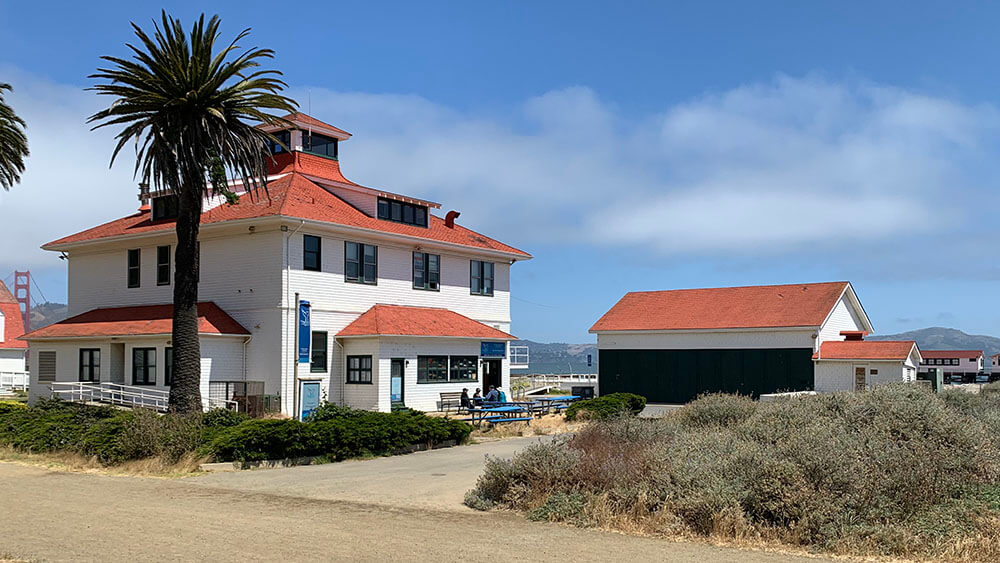NOAA announces $2 million for renovation of historic structure for Greater Farallones and Cordell Bank National Marine Sanctuaries
Contact: Jennifer Stock, jennifer.stock@noaa.gov, 415-686-1864

August 1, 2023
NOAA will invest $2 million from the Inflation Reduction Act in NOAA’s Greater Farallones and Cordell Bank National Marine Sanctuaries to support critical repairs and updates to a facility on the sanctuaries’ campus in San Francisco.
NOAA intends to renovate a historic former lifeboat station garage and convert it into an ocean learning center for hands-on education and outreach on marine conservation.
“NOAA’s national marine sanctuaries facilities are a gateway to our greatest underwater treasures — and key to maintaining them,” said U.S. Secretary of Commerce Gina Raimondo. “This funding will provide critical upgrades to NOAA’s Greater Farallones and Cordell Bank National Marine Sanctuaries facilities and represents President Biden’s commitment to investing in America.”
“For over 40 years, the Greater Farallones National Marine Sanctuary has helped protect the diverse marine ecosystem of the northern and central California coast as well as provided meaningful research, recreation, and educational opportunities,” said Senator Padilla. “I applaud this funding from NOAA through the Inflation Reduction Act to sustain the growing local tourist economy and support crucial education and sustainability programs by delivering essential repairs to the Sanctuary’s Visitor Center.”
“The Greater Farallones Marine Sanctuary is a treasured part of my district — home to a diverse and productive ecosystem that supports our region and has deep cultural significance to local tribes. We must invest in sanctuary programs like this to ensure they can continue their mission of protecting our coasts while spreading awareness on both the benefits of healthy marine ecosystems and the threats they face from the unrelenting climate crisis,” said Congressman Jared Huffman (CA-02). “I made it a priority to include this type of funding in the Inflation Reduction Act, and I’m incredibly glad to see a keystone of our region receive one of these grants. The repairs and upgrades for the Visitor Center at Crissy Field, made possible through this latest tranche of funding, will go a long way in helping the sanctuary boost tourism and spur educational opportunities.”
The campus, which supports both Greater Farallones and Cordell Bank National Marine Sanctuaries, is located on the promenade of Golden Gate National Recreation Area’s (GGNRA) Crissy Field, which attracts over a million visitors and locals annually for recreation. The facility slated for improvements is part of the former Fort Point U.S. Coast Guard Station and part of the Presidio of San Francisco National Historic Landmark.
NOAA intends for the renovated facility to support student and public programs, including events such as Sharktoberfest, and to provide a location for collaboration among the sanctuaries and community partners. The renovation would augment the existing visitor center located in an adjacent building that also houses sanctuary offices.
The existing visitor center, which opened in 1998, was one of the first visitor centers in the National Marine Sanctuary System. Since the center opened, there have been few updates to exhibits. The renovated facility would expand the sanctuary’s ability to serve students and communities through educational programming.
Greater Farallones National Marine Sanctuary encompasses 3,295 square miles of marine waters off the northern and central California coast. It supports an abundance of life, including many threatened and endangered species. The offshore 1,286 square mile Cordell Bank National Marine Sanctuary protects soft seafloor habitat, a rocky bank, deep sea canyons and diverse communities of wildlife.
Both are part of America’s National Marine Sanctuary system, a network of underwater parks encompassing more than 620,000 square miles of marine and Great Lakes waters. The network includes a system of 15 national marine sanctuaries and Papahānaumokuākea and Rose Atoll marine national monuments.
These investments are part of a $3.3 billion total investment from the Inflation Reduction Act that is enabling NOAA to build on its commitment to help Americans — including tribes and vulnerable populations — prepare, adapt and build resilience to weather and climate events; improve supercomputing capacity and research on weather, oceans and climate; strengthen NOAA’s hurricane hunter aircraft and fleet; and replace aging NOAA facilities. Stay updated about NOAA’s Inflation Reduction Act investments.

